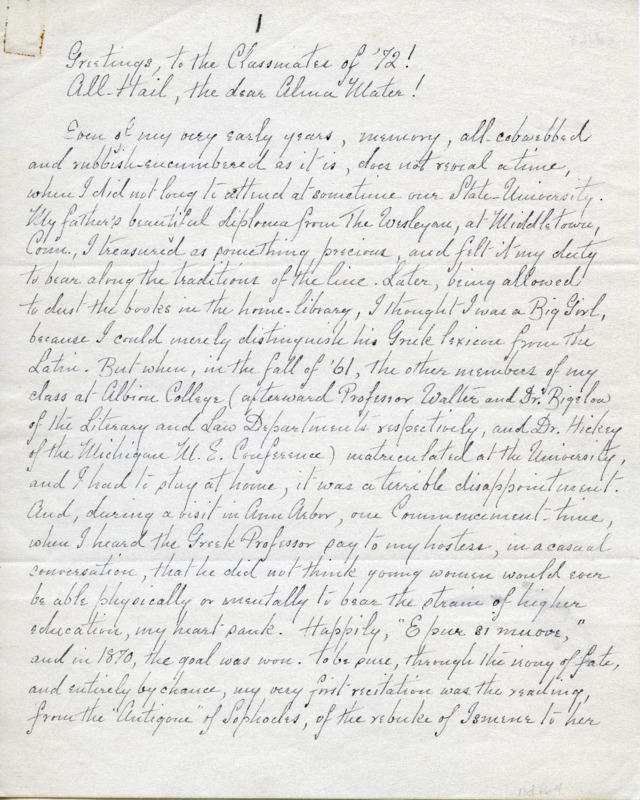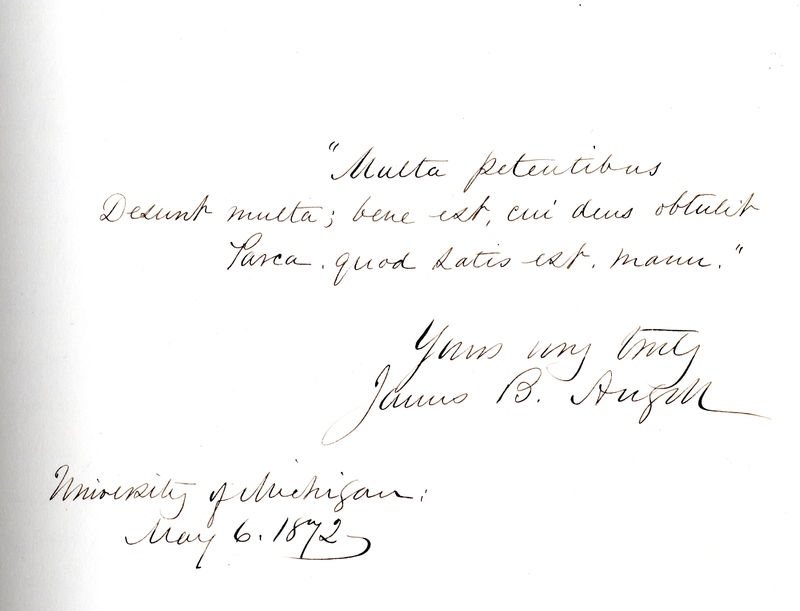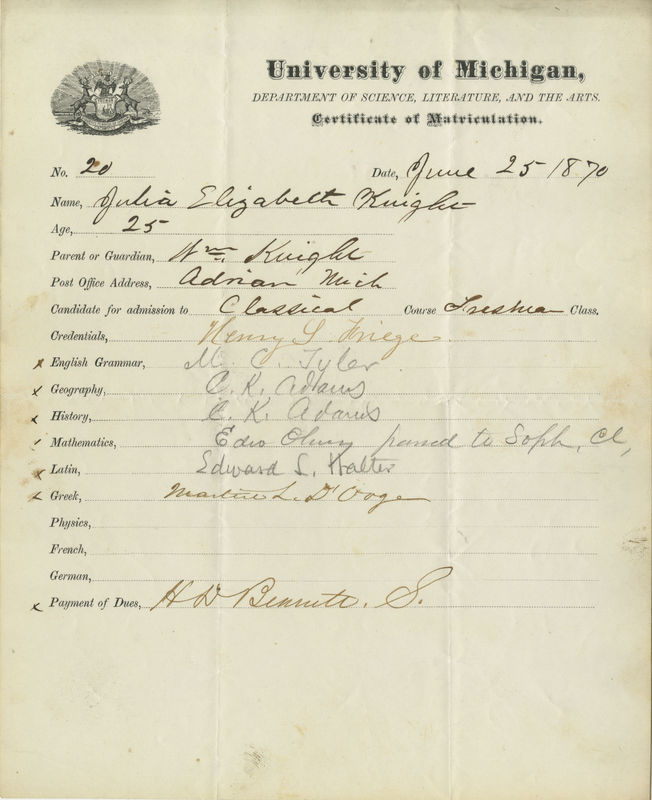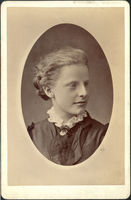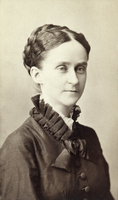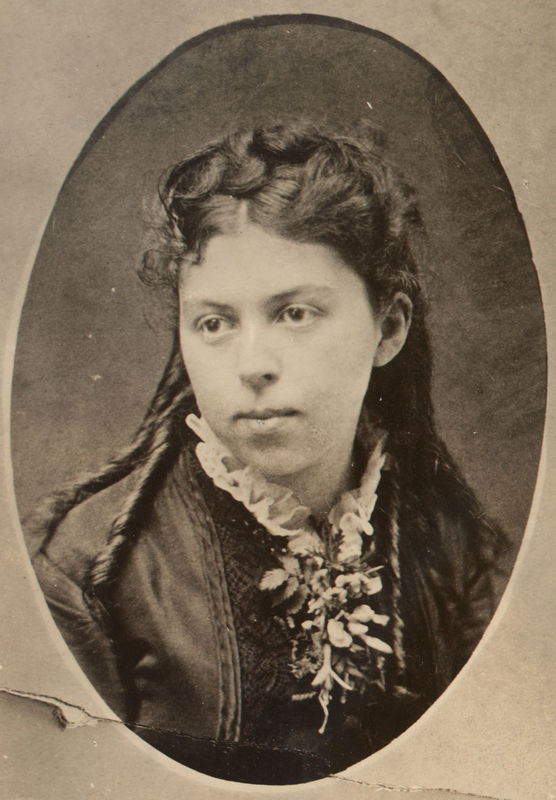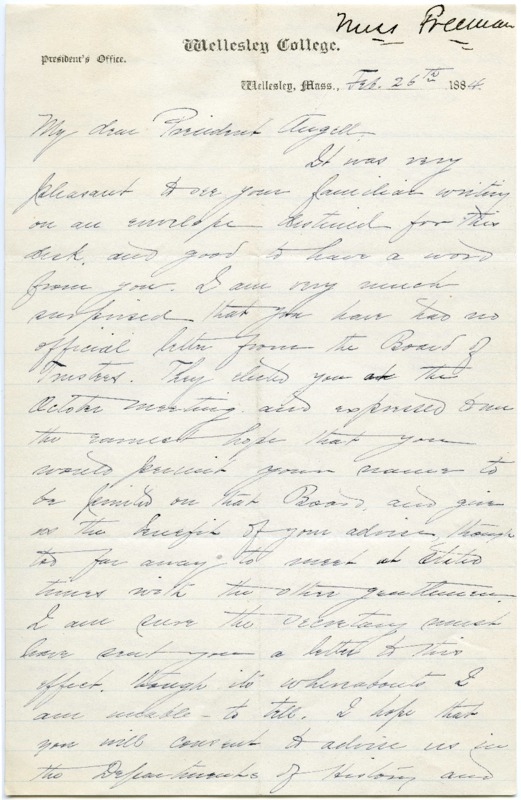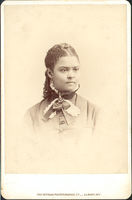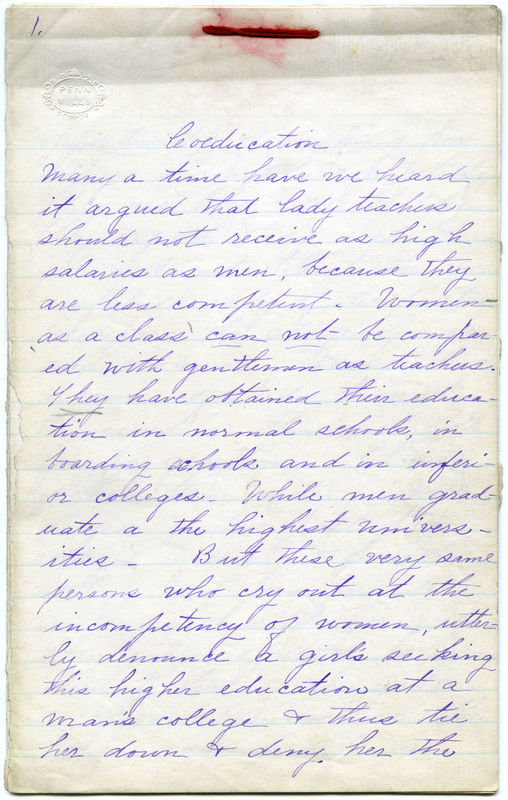Student Experiences
Madelon Stockwell
Madelon Stockwell was the first woman allowed to enroll at the University of Michigan, entering as a sophomore in February 1870. She had attended the preparatory school at Kalamazoo College run by Lucinda Hinsdale Stone, and graduated from Albion College in 1862, where her father had been principal. While many of her male classmates moved on to the University of Michigan, Madelon could not. She instead returned to Kalamazoo and taught art. When it was announced that women were to be permitted to enroll at Michigan, it was Stone who suggested Madelon’s name to Regent George Willard. [1]
Madelon wrote a letter to her classmates in 1919 about how reaching the University was a dream that she initially did not think she would achieve. “The years! Those brightly beckoning years, in 1872! How much they meant! The Dream of Life.” [2]
President James B. Angell signed Stockwell’s personal autograph book, now kept at the Albion College Library, on May 6, 1872, leading up to graduation. He included with his signature a quote in Latin from an Ode by Horace that recognized Madelon’s patience and hard work: Multa petentibus / desunt multa. Bene est, cui Deus obtulit / parca, quod satis est manu. “Those who long for much are in want of much: Happy is he to whom God has given, with sparing hand, as much as is enough.”[3]
Madelon Stockwell returned to Ann Arbor several times after graduation, including in 1907 when she attended the 35th reunion of the class of 1872. A photo of the returning members of the class and their families was taken outside the home of classmate and local businessman Evart A. Scott on Washtenaw Avenue. Madelon Stockwell Turner is seated at the very center wearing a black hat.
In 1912, Stockwell was granted an honorary Master of Arts degree at commencement in recognition of being the woman “who by her poise dignity and scholarship conquered at once what many were thought to be insurmountable obstacles.” [4] Upon her death in 1924, she left $10,000 to the University to establish a scholarship to assist other women to receive a university education in the Department of Literature, Science and the Arts, as she had done. Stockwell Hall, which opened as a women’s dorm in 1940, was named after her.
Julia Knight
Following Madelon Stockwell’s enrollment the previous semester, Julia Knight was the first woman to be admitted to the University as a freshman in the summer of 1870. She entered that fall with 32 other women as part of the class of 1874. To enroll at the University, she needed to be present in Ann Arbor to take entrance exams on each subject, receiving the approval of the president. Julia Knight did so well in Mathematics, that she was placed into the sophomore course, according to her certificate of matriculation.
Caroline Hubbard
Caroline Hubbard was born in Kalamazoo, Michigan in 1855 to a progressive family. She was admitted to the University of Michigan in 1871 and graduated with a bachelor's degree in 1875. She remained in Ann Arbor to complete a Master of Science degree, becoming the first woman at the University to do so in 1876. She married Carl Kleinstueck in 1883 and returned to Kalamazoo, where she was a leader in the fight for women’s suffrage in Michigan. Throughout her life she was an active supporter of the University. She was the first donor to the campaign to raise funds for the Michigan League building, and helped lead the effort. Kleinstueck House in Alice Lloyd Hall was named in her honor in 1949.
Olive San Louie Anderson
Following her graduation, Olive San Louie Anderson, class of 1875 published the novelized memoir An American Girl and her Four Years in a Boy’s College. The main character of Wilhelmine Elliot is one of the first women to attend the University of Ortonville, a thinly veiled University of Michigan. Anderson wrote the book under the pseudonym “SOLA”—her initials rearranged.
The Bentley’s copy of the novel includes notes in the margins revealing the true identities of some of the people that Anderson wrote about. The character Clara Hopkins was likely her freshman roommate, Emma Hall, and Professor Markham was certainly Professor James C. Watson, director of the Observatory.
Alice Boise
Before Madelon Stockwell enrolled in 1870, Alice Boise, daughter of Professor of Greek James Boise, audited his classes and others in the Greek Department in 1866. This was with the permission of President Haven, but she was not allowed to formally register and her name was not recorded. Alice Boise enrolled at the University of Chicago in 1868 when her father received an appointment there, and became the first woman to graduate from that institution in 1872. [5]
Alice Freeman Palmer
When Alice Freeman came to Ann Arbor to take the entrance examination for enrollment in 1872, her results were less than stellar. However, President Angell was personally impressed and allowed her to enroll with conditions, which she met ahead of schedule. After graduating in 1876, she became a teacher, and in 1879 started as chair of the history department at Wellesley College. Just two years later, she was named president of the school, significantly raising the standards and leaving a lasting impact on the institution. Freeman and Angell remained in touch, and in their correspondence she often asked his advice. In 1882, at the age of only 27, the University conferred upon her the honorary degree of Doctor of Philosophy for her achievement. [6]
In 1887, she left Wellesley and married George Palmer, Professor of Philosophy at Harvard University. She continued to write and speak nationally about the education of women, for a time as the dean of women at the University of Chicago. She would return to Ann Arbor several times to address students, speaking to the Women’s League and the Student Christian Association.
Mary Graham
Mary Henrietta Graham is recognized as the first African American woman to attend and graduate from the University of Michigan. She was born in Windsor, Ontario in 1857 and raised in Flint, Michigan. She enrolled at the University in 1876 and graduated with a Ph. B in 1880. After graduation she became an instructor at Lincoln Institute in Jefferson City, Missouri, the state normal school for African Americans. In 1882 she married Ferdinand Lee Barnett, an attorney in Chicago. While living in Chicago she started reporting for the Chicago Conservator, the city's first African American newspaper which her husband had helped to start in 1878, and two years later took the position of city editor. She died suddenly on January 2, 1890, leaving behind her husband and two children.
Eliza Darling
As a high school student at in Laporte, Indiana, Eliza Darling was inspired by the first women to enroll at the university she would later attend. In 1876 she wrote an essay titled “Co-education” in which she gave the success of women at Michigan as central evidence against those who said women were not capable of the same level of study as men. “Wise mankind have decreed that a woman is not given the brain a man is given and so she can not compete with him—the idea has been proven perfectly false. The average scholarship of the girls at Ann Arbor is equal to the average scholarship of the boys.” After graduating from the University herself in 1882, Darling taught at the Wisconsin State Normal School and then at Wellesley College, which at the time was directed by fellow U-M alumna Alice Freeman Palmer, until her marriage to fellow educator Lawrence Hull in 1886. [7]
Notes
[1] Huber, J. Parker. “Toward Camelot : The Admission of Women to the University of Michigan.” Book. Bulletin (Michigan Historical Collections); No. 18. Ann Arbor : Michigan Historical Collections, University of Michigan, 1970, Page 11.
[2] Letter from Madelon Stockwell Turner to the Class of 1872, 1919. Madelon Stockwell Correspondence, Bentley Historical Library, University of Michigan.
[3] Horace. Carmina, book 3, XVI, lines 42-44.
[4] “Proceedings of the Board of Regents .” June 1912, p. 478. Ann Arbor : The University.
[5] Huber, “Toward Camelot", Page 15.
[6] Letter from Alice Freeman Palmer to James B. Angell, February 26, 1884. Box 9, "James B. Angell Papers" Bentley Historical Library, University of Michigan.
[7]"Co-education", 1869. Eliza Darling Hull Student papers 1873-1882, Box 1 “Hull Family Papers.” Bentley Historical Library, University of Michigan,


